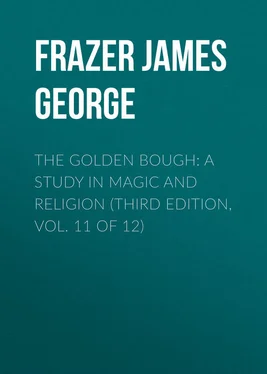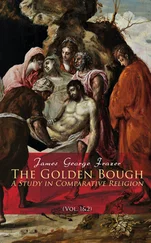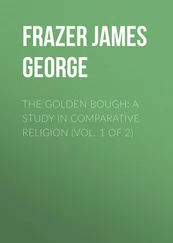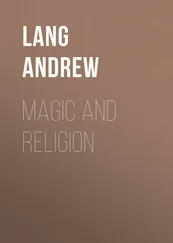James Frazer - The Golden Bough - A Study in Magic and Religion (Third Edition, Vol. 11 of 12)
Здесь есть возможность читать онлайн «James Frazer - The Golden Bough - A Study in Magic and Religion (Third Edition, Vol. 11 of 12)» — ознакомительный отрывок электронной книги совершенно бесплатно, а после прочтения отрывка купить полную версию. В некоторых случаях можно слушать аудио, скачать через торрент в формате fb2 и присутствует краткое содержание. Жанр: foreign_religion, foreign_antique, foreign_prose, на английском языке. Описание произведения, (предисловие) а так же отзывы посетителей доступны на портале библиотеки ЛибКат.
- Название:The Golden Bough: A Study in Magic and Religion (Third Edition, Vol. 11 of 12)
- Автор:
- Жанр:
- Год:неизвестен
- ISBN:нет данных
- Рейтинг книги:4 / 5. Голосов: 1
-
Избранное:Добавить в избранное
- Отзывы:
-
Ваша оценка:
- 80
- 1
- 2
- 3
- 4
- 5
The Golden Bough: A Study in Magic and Religion (Third Edition, Vol. 11 of 12): краткое содержание, описание и аннотация
Предлагаем к чтению аннотацию, описание, краткое содержание или предисловие (зависит от того, что написал сам автор книги «The Golden Bough: A Study in Magic and Religion (Third Edition, Vol. 11 of 12)»). Если вы не нашли необходимую информацию о книге — напишите в комментариях, мы постараемся отыскать её.
The Golden Bough: A Study in Magic and Religion (Third Edition, Vol. 11 of 12) — читать онлайн ознакомительный отрывок
Ниже представлен текст книги, разбитый по страницам. Система сохранения места последней прочитанной страницы, позволяет с удобством читать онлайн бесплатно книгу «The Golden Bough: A Study in Magic and Religion (Third Edition, Vol. 11 of 12)», без необходимости каждый раз заново искать на чём Вы остановились. Поставьте закладку, и сможете в любой момент перейти на страницу, на которой закончили чтение.
Интервал:
Закладка:
James George Frazer
The Golden Bough: A Study in Magic and Religion (Third Edition, Vol. 11 of 12)
Chapter VI. Fire-Festivals in Other Lands
§ 1. The Fire-walk
Bonfires at the Pongol festival in Southern India.
At first sight the interpretation of the European fire customs as charms for making sunshine is confirmed by a parallel custom observed by the Hindoos of Southern India at the Pongol or Feast of Ingathering. The festival is celebrated in the early part of January, when, according to Hindoo astrologers, the sun enters the tropic of Capricorn, and the chief event of the festival coincides with the passage of the sun. For some days previously the boys gather heaps of sticks, straw, dead leaves, and everything that will burn. On the morning of the first day of the festival the heaps are fired. Every street and lane has its bonfire. The young folk leap over the flames or pile on fresh fuel. This fire is an offering to Sûrya, the sun-god, or to Agni, the deity of fire; it “wakes him from his sleep, calling on him again to gladden the earth with his light and heat.” 1 1 Ch. E. Gover, “The Pongol Festival in Southern India,” Journal of the Royal Asiatic Society , N.S., v. (1870) pp. 96 sq.
If this is indeed the explanation which the people themselves give of the festival, it seems decisive in favour of the solar explanation of the fires; for to say that the fires waken the sun-god from his sleep is only a metaphorical or mythical way of saying that they actually help to rekindle the sun's light and heat. But the hesitation which the writer indicates between the two distinct deities of sun and fire seems to prove that he is merely giving his own interpretation of the rite, not reporting the views of the celebrants. If that is so, the expression of his opinion has no claim to authority.
Bonfires at the Holi festival in Northern India. The village priest expected to pass through the fire. Leaping over the ashes of the fire to get rid of disease.
A festival of Northern India which presents points of resemblance to the popular European celebrations which we have been considering is the Holi. This is a village festival held in early spring at the full moon of the month Phalgun. Large bonfires are lit and young people dance round them. The people believe that the fires prevent blight, and that the ashes cure disease. At Barsana the local village priest is expected to pass through the Holi bonfire, which, in the opinion of the faithful, cannot burn him. Indeed he holds his land rent-free simply on the score of his being fire-proof. On one occasion when the priest disappointed the expectant crowd by merely jumping over the outermost verge of the smouldering ashes and then bolting into his cell, they threatened to deprive him of his benefice if he did not discharge his spiritual functions better when the next Holi season came round. Another feature of the festival which has, or once had, its counterpart in the corresponding European ceremonies is the unchecked profligacy which prevails among the Hindoos at this time. 2 2 W. Crooke, Popular Religion and Folk-lore of Northern India (Westminster, 1896), ii. 314 sqq. ; Captain G. R. Hearn, “Passing through the Fire at Phalon,” Man , v. (1905) pp. 154 sq. On the custom of walking through fire, or rather over a furnace, see Andrew Lang, Modern Mythology (London, 1897), pp. 148-175; id. , in Athenaeum , 26th August and 14th October, 1899; id. , in Folk-lore , xii. (1901) pp. 452-455; id. , in Folk-lore , xiv. (1903) pp. 87-89. Mr. Lang was the first to call attention to the wide prevalence of the rite in many parts of the world.
In Kumaon, a district of North-West India, at the foot of the Himalayas, each clan celebrates the Holi festival by cutting down a tree, which is thereupon stripped of its leaves, decked with shreds of cloth, and burnt at some convenient place in the quarter of the town inhabited by the clan. Some of the songs sung on this occasion are of a ribald character. The people leap over the ashes of the fire, believing that they thus rid themselves of itch and other diseases of the skin. While the trees are burning, each clan tries to carry off strips of cloth from the tree of another clan, and success in the attempt is thought to ensure good luck. In Gwalior large heaps of cow-dung are burnt instead of trees. Among the Marwaris the festival is celebrated by the women with obscene songs and gestures. A monstrous and disgusting image of a certain Nathuram, who is said to have been a notorious profligate, is set up in a bazaar and then smashed with blows of shoes and bludgeons while the bonfire of cow-dung is blazing. No household can be without an image of Nathuram, and on the night when the bride first visits her husband, the image of this disreputable personage is placed beside her couch. Barren women and mothers whose children have died look to Nathuram for deliverance from their troubles. 3 3 Pandit Janardan Joshi, in North Indian Notes and Queries , iii. pp. 92 sq. , § 199 (September, 1893); W. Crooke, Popular Religion and Folk-lore of Northern India (Westminster, 1896), ii. 318 sq.
Various stories are told to account for the origin of the Holi festival. According to one legend it was instituted in order to get rid of a troublesome demon ( rákshasí ). The people were directed to kindle a bonfire and circumambulate it, singing and uttering fearlessly whatever might come into their minds. Appalled by these vociferations, by the oblations to fire, and by the laughter of the children, the demon was to be destroyed. 4 4 E. T. Atkinson, “Notes on the History of Religion in the Himalayas of the N.W. Provinces,” Journal of the Asiatic Society of Bengal , liii. Part i. (Calcutta, 1884) p. 60. Compare W. Crooke, Popular Religion and Folk-lore of Northern India (Westminster, 1896), ii. 313 sq.
Vernal festival of fire in China. Ceremony to ensure an abundant year. Walking through the fire. Ashes of the fire mixed with the fodder of the cattle.
In the Chinese province of Fo-Kien we also meet with a vernal festival of fire which may be compared to the fire-festivals of Europe. The ceremony, according to an eminent authority, is a solar festival in honour of the renewal of vegetation and of the vernal warmth. It falls in April, on the thirteenth day of the third month in the Chinese calendar, and is doubtless connected with the ancient custom of renewing the fire, which, as we saw, used to be observed in China at this season. 5 5 See above, vol. i. pp. 136 sq.
The chief performers in the ceremony are labourers, who refrain from women for seven days, and fast for three days before the festival. During these days they are taught in the temple how to discharge the difficult and dangerous duty which is to be laid upon them. On the eve of the festival an enormous brazier of charcoal, sometimes twenty feet wide, is prepared in front of the temple of the Great God, the protector of life. At sunrise next morning the brazier is lighted and kept burning by fresh supplies of fuel. A Taoist priest throws a mixture of salt and rice on the fire to conjure the flames and ensure an abundant year. Further, two exorcists, barefooted and followed by two peasants, traverse the fire again and again till it is somewhat beaten down. Meantime the procession is forming in the temple. The image of the god of the temple is placed in a sedan-chair, resplendent with red paint and gilding, and is carried forth by a score or more of barefooted peasants. On the shafts of the sedan-chair, behind the image, stands a magician with a dagger stuck through the upper parts of his arms and grasping in each hand a great sword, with which he essays to deal himself violent blows on the back; however, the strokes as they descend are mostly parried by peasants, who walk behind him and interpose bamboo rods between his back and the swords.
Интервал:
Закладка:
Похожие книги на «The Golden Bough: A Study in Magic and Religion (Third Edition, Vol. 11 of 12)»
Представляем Вашему вниманию похожие книги на «The Golden Bough: A Study in Magic and Religion (Third Edition, Vol. 11 of 12)» списком для выбора. Мы отобрали схожую по названию и смыслу литературу в надежде предоставить читателям больше вариантов отыскать новые, интересные, ещё непрочитанные произведения.
Обсуждение, отзывы о книге «The Golden Bough: A Study in Magic and Religion (Third Edition, Vol. 11 of 12)» и просто собственные мнения читателей. Оставьте ваши комментарии, напишите, что Вы думаете о произведении, его смысле или главных героях. Укажите что конкретно понравилось, а что нет, и почему Вы так считаете.












